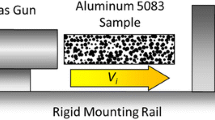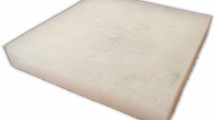Abstract
Reverse ballistic impact tests are widely used for studying dynamic responses because they provide more comprehensive and quantitative projectile/rod response results than forward impact tests. To examine equivalent forward and reverse conditions, a series of 8-cm length oxygen-free copper rods with varying length–diameter ratios was used in forward and reverse ballistic Taylor impact experiments with velocities and strain ratios of 104–215 m/s and 1.25 × 103–2.5 × 103 s-1, respectively. Digital image correlation (DIC) and traditional optical measurements were used to determine instantaneous responses at the μs level. Based on DIC, transient structural deformation, and plastic wave propagation, the forward and reverse length difference at similar velocities ranges from 2 to 6.95 %. Rules governing deformation from the perspective of energy, along with rules for changes in energy and plastic wave propagation were determined. The relative deformation energy error was below 5 % for target projectile mass ratios above 20.



























Similar content being viewed by others
Abbreviations
- A 0 :
-
Initial sectional area
- C :
-
Correlation coefficient in equation (14)
- Cf :
-
Elastic velocity in forward impact at t 1
- C r :
-
Elastic wave velocity in reverse impact at t 1
- D :
-
Diameter of specimen
- E :
-
Young’s modulus of the material
- E fin :
-
Total input energy of forward impact
- E fp :
-
Deformation energy of forward impact
- E rin :
-
Total input energy of reverse impact
- E rk :
-
Kinetic energy of reverse ballistic test after impact
- E rkr :
-
Kinetic energy of the specimen
- E rkp :
-
Kinetic energy of the plate
- E rp :
-
Deformation energy of reverse impact
- F cr :
-
Yield force of the cross section
- f (x y):
-
Pixel matrix of M in equation (14)
- g (x * y *):
-
Pixel matrix of M 1 in equation (14)
- L 0 :
-
Initial length of the specimen
- L 1 :
-
Total length at t 1
- L 2 :
-
Total length at t 2
- m :
-
Number of pixels
- m r :
-
Mass ratio of the rigid plate to the specimen
- M :
-
Center point of sub-region S in Fig. 22
- M 1 :
-
Point after M moves in Fig. 22
- n j :
-
Vector shown in Fig. 15
- n i :
-
Normal to the cross section in Fig. 15
- N :
-
Axial force
- R 0 :
-
Initial radius of the specimen
- R 2 :
-
Radius of the specimen after impact
- S :
-
Sub-region in Fig. 22
- S 1 :
-
Sub-region after S moves in Fig. 22
- t 0 :
-
Initial time of impact
- t 1 :
-
Time during the impact process
- t 2 :
-
Final time of the impact process
- u 1f :
-
Particle velocity of elastic region in forward impact at t 1
- u 1r :
-
Particle velocity of elastic region in reverse impact at t 1
- u 2r :
-
Particle velocity of plastic region in reverse impact at t 1
- u f :
-
Initial velocity of forward impact
- u r :
-
Initial velocity in reverse impact
- u rr :
-
Velocity after reverse impact
- v 0 :
-
Initial impact velocity
- v f :
-
Plastic velocity in reverse impact at t 1
- v r :
-
Plastic wave velocity in reverse impact at t 1
- x 1 :
-
Undeformed length at t 1
- x 2 :
-
Undeformed length at t 2
- Y :
-
Dynamic strength of material
- ρ :
-
Specimen density
- σ ij :
-
Stress tensor
- σ s :
-
Tensile strength
- \( \overset{\cdot }{\varepsilon } \) :
-
Strain ratio of material
References
Taylor G (1948) The use of flat-ended projectiles for determining dynamic yield stress. Proc R Soc London, Ser A 194(1038):289–299, http://www.jstor.org/stable/98289
Chen XW, Chen G, Zhang FJ (2007) Deformation and failure modes of soft steel projectiles impacting harder steel targets at increasing velocity. Exp Mech 48(3):335–354. doi:10.1007/s11340-007-9110-4
Allen DJ, Rule WK, Jones SE (1997) Optimizing material strength constants numerically extracted from taylor impact data. Exp Mech 37(3):333–338. doi:10.1007/BF02317427
House JW, Aref B, Foster JC, Gillis PP (1999) Film data reduction from Taylor impact tests. J Strain Anal Eng Des 34(5):337–345. doi:10.1243/0309324991513678
Davila A, Huntley JM, Kaufmann GH, Kerr D (2005) High-speed dynamic speckle interferometry: phase errors due to intensity, velocity, and speckle decorrelation. Appl Opt 44(19):3954–3962. doi:10.1364/AO.44.003954
Rakvåg KG, Børvik T, Westermann I, Hopperstad OS (2013) An experimental study on the deformation and fracture modes of steel projectiles during impact. Mater Des 51:242–256. doi:10.1016/j.matdes.2013.04.036
Erlich DC, Shockey DA (1984) Chapter III : 6 - Dynamic Flow Curve of 4340 Steel as Determined by the Symmetric Rod Impact Test. Shock Waves in Condensed Matter 1983. Elsevier, Amsterdam. doi:10.1016/B978-0-444-86904-3.50030-0
Jones SE, Gillis PP, Foster JJC, Wilson LL (1991) A One-dimensional, Two-phase flow model for Taylor impact specimens. J Eng Mater Technol 113(2):228–235. doi:10.1115/1.2903397
Jones SE, Maudlin PJ, Foster JC (1997) An engineering analysis of plastic wave propagation in the Taylor test. Int J Impact Eng 19(2):95–106. doi:10.1016/S0734-743X(96)00020-6
Holt WH, Mock W, Soper WG, Coffey CS, Ramachandran V, Armstrong RW (1993) Reverse-ballistic impact study of shear plug formation and displacement in Ti6Al4V alloy. J Appl Phys 73(8):3753. doi:10.1063/1.354053
Subramanian R, Bless SJ, Cazamias J, Berry D (1995) Reverse impact experiments against tungsten rods and results for aluminum penetration between 1.5 and 4.2 km/s. Int J Impact Eng 17(4–6):817–824. doi:10.1016/0734-743X(95)99902-4
Ferranti L, Thadhani NN (2007) Incremental stress-strain response of polymers using instrumented reverse Taylor anvil impacts. AIP Conf Proc 955(1):699–702. doi:10.1063/1.2833209
Anderson CE Jr, Behner T, Holmquist TJ, Orphal DL (2011) Penetration response of silicon carbide as a function of impact velocity. Int J Impact Eng 38(11):892–899. doi:10.1016/j.ijimpeng.2011.06.002
Behner T, Orphal D, Hohler V, Anderson C Jr, Mason R, Templeton D (2006) Hypervelocity penetration of gold rods into SiC-N for impact velocities from 2.0 to 6.2 km/s. Int J Impact Eng 33(1):68–79. doi:10.1016/j.ijimpeng.2006.09.082
Lidén E, Johansson B, Lundberg B (2006) Effect of thin oblique moving plates on long rod projectiles: A reverse impact study. Int J Impact Eng 32(10):1696–1720. doi:10.1016/j.ijimpeng.2005.02.004
Eakins D, Thadhani NN (2007) Analysis of dynamic mechanical behavior in reverse Taylor anvil-on-rod impact tests. Int J Impact Eng 34(11):1821–1834. doi:10.1016/j.ijimpeng.2006.11.001
Eakins D, Thadhani NN (2006) Instrumented Taylor anvil-on-rod impact tests for validating applicability of standard strength models to transient deformation states. J Appl Phys 100(7):073503. doi:10.1063/1.2354326
Pan B, Qian K, Xie H, Asundi A (2009) Two-dimensional digital image correlation for in-plane displacement and strain measurement: a review. Measurement Science & Technology 20(6). doi:10.1088/0957-0233/20/6/062001
Peters WH, Ranson WF (1982) Digital imaging techniques in experimental stress analysis. Opt Eng 21(3):427–431. doi:10.1117/12.7972925
Peters WH, Ranson WF, Sutton MA, Chu TC, Anderson J (1983) Application of digital correlation methods to rigid body mechanics. Opt Eng 22(6):738–742. doi:10.1117/12.7973231
Sutton MA, Mingqi C, Peters WH, Chao YJ, McNeill SR (1986) Application of an optimized digital correlation method to planar deformation analysis. Image Vis Comput 4(3):143–150. doi:10.1016/0262-8856(86)90057-0
Cofaru C, Philips W, Van Paepegem W (2012) A three-frame digital image correlation (DIC) method for the measurement of small displacements and strains. Meas Sci Technol 23(10):105406. doi:10.1088/0957-0233/23/10/105406
Pierron F, Sutton MA, Tiwari V (2010) Ultra high speed DIC and virtual fields method analysis of a three point bending impact test on an aluminium bar. Exp Mech 51(4):537–563. doi:10.1007/s11340-010-9402-y
Kumar P, LeBlanc J, Stargel DS, Shukla A (2012) Effect of plate curvature on blast response of aluminum panels. Int J Impact Eng 46:74–85. doi:10.1016/j.ijimpeng.2012.02.004
Tang T-g, Liu C-l (2013) On the constitutive model for wxygen-free high-conductivity copper under high strain-rate tension. Explosion and Shock Waves 33 (6):581–586. doi:10.3969/j.issn.1001-1455.2013.06.004 (in Chinese)
Mocko W, Janiszewski J, Grazka M (2013) Application of an extended Rusinek-Klepaczko constitutive model to predict the mechanical behavior of 6082-T6 aluminum under Taylor impact test conditions. J Strain Anal Eng Des 48(6):364–375. doi:10.1177/0309324713488885
Heider N, Weber K, Weidemaier P (2004) Experimental and numerical simulation analysis of the impact process of structured KE penetrators onto semi-infinite and oblique plate targets. In: 21st International Symposium on Ballistics, Adelaide; AU
Grantham SG, Siviour CR, Proud WG, Field JE (2004) High strain rate Brazilian testing of an explosive simulant using speckle metrology. Meas Sci Technol 15(9):1867–1870. doi:10.1088/0957-0233/15/9/025
Acknowledgments
This work was supported by the National Natural Science Foundation of China (No.11202029, No.11390362, No.11221202).
Author information
Authors and Affiliations
Corresponding author
Rights and permissions
About this article
Cite this article
Liu, J., Huang, F., Xu, K. et al. Influence of Mass Ratio on Forward and Reverse Ballistic Impact Equivalence: Experiments, Simulations, and Mechanism Analysis. Exp Mech 57, 387–404 (2017). https://doi.org/10.1007/s11340-016-0225-3
Received:
Accepted:
Published:
Issue Date:
DOI: https://doi.org/10.1007/s11340-016-0225-3




